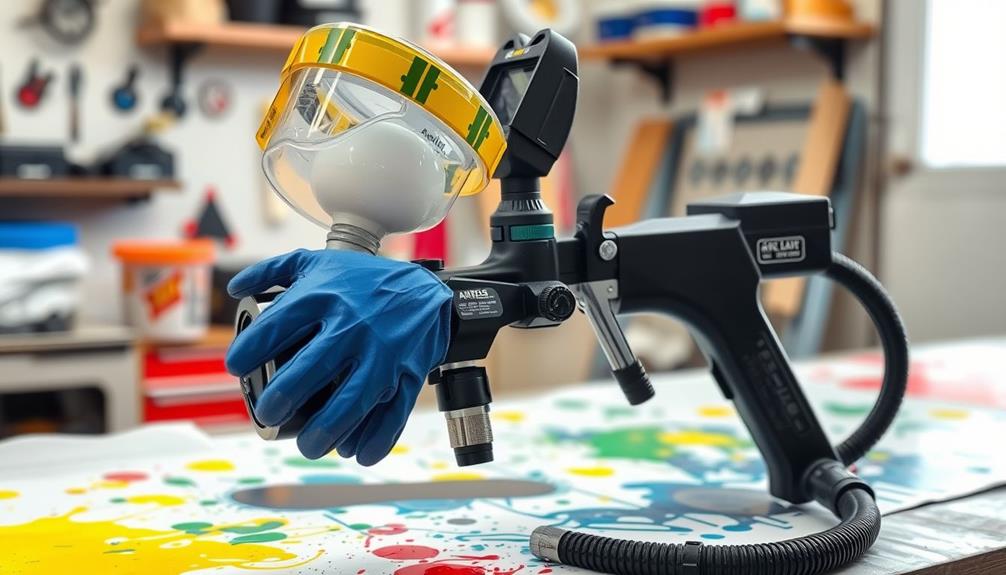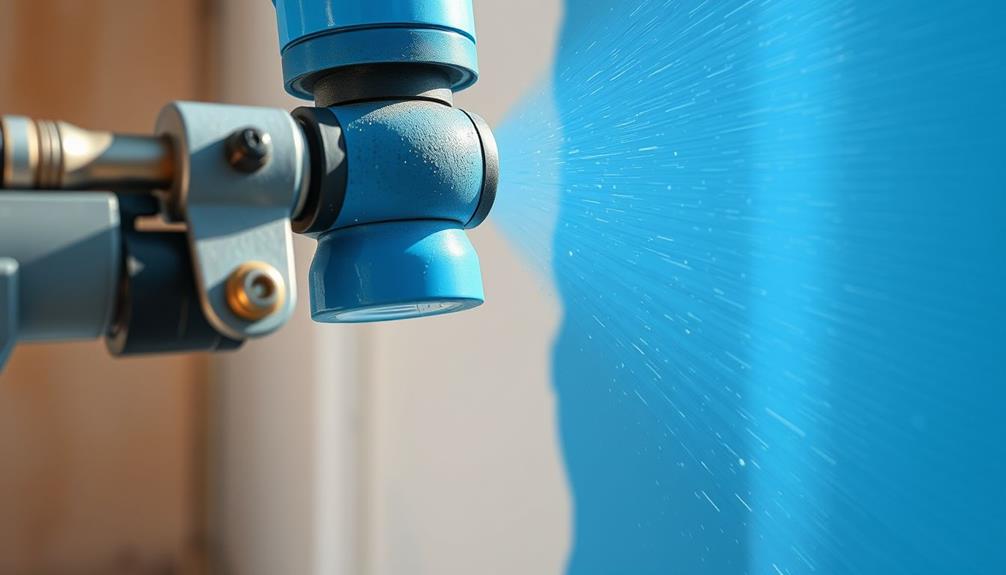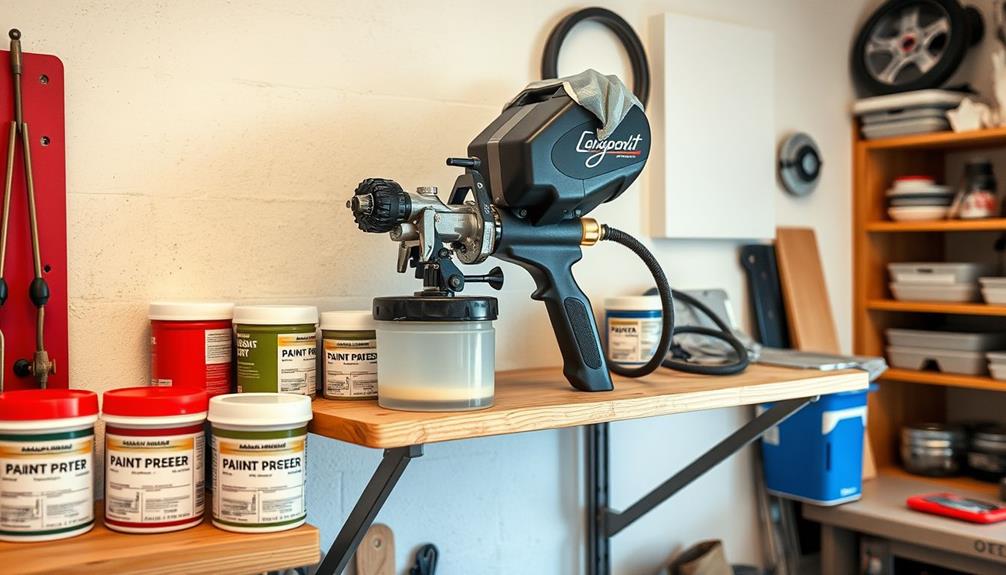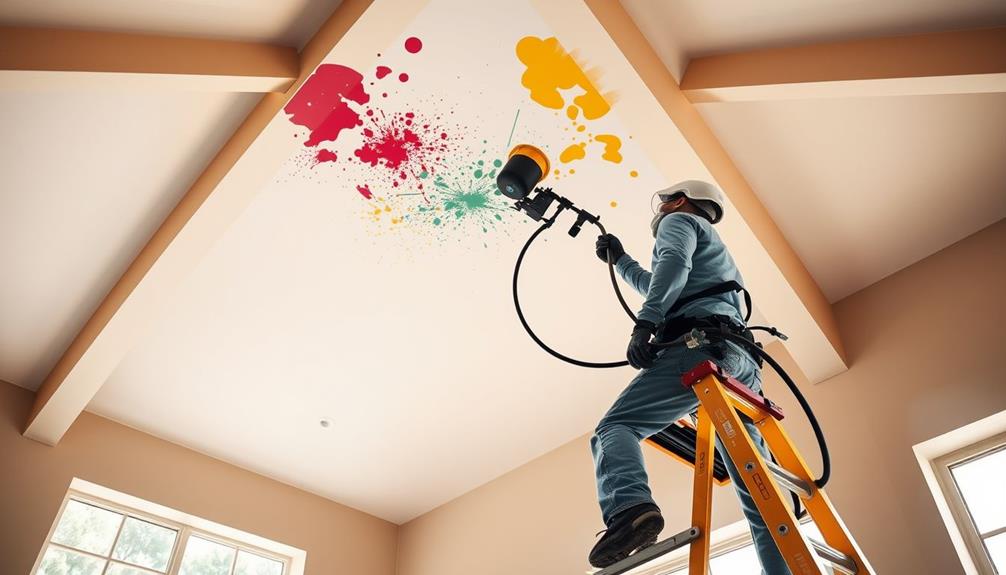Airless paint sprayer safety is essential for protecting yourself and others during your projects. Always wear proper personal protective equipment, including safety goggles and gloves, to minimize risks. Make certain your work area is well-ventilated to avoid fire hazards from flammable vapors. Be aware of injection risks from high-pressure fluid; use tip guards and engage safety locks when not spraying. Regularly inspect and maintain your equipment to prevent malfunctions. If any accidents occur, seek immediate medical attention. By prioritizing safety, you'll guarantee a more effective and worry-free painting experience. There's plenty more you should know to stay safe and successful.
Key Takeaways
- Proper training and adherence to safety protocols are essential to minimize risks associated with airless paint sprayers.
- Regular inspections and maintenance of equipment prevent leaks and ensure safe operation during use.
- Always wear appropriate personal protective equipment, including safety goggles and respirators, to protect against hazardous materials.
- Ensure adequate ventilation in the workspace to reduce the risk of fire and explosion from flammable vapors.
- Seek immediate medical attention for any suspected injection injury, regardless of its severity, to prevent long-term harm.
Importance of Safety
When it comes to operating airless paint sprayers, safety is absolutely essential. You need to recognize that safety is a collective responsibility among everyone involved with the equipment. Proper training and strict adherence to safety protocols can markedly reduce the risk of accidents and injuries.
Understanding airless paint sprayer basics can help users recognize the potential hazards associated with high-pressure equipment. Graco, a trusted name in the industry, provides reliable products along with critical safety information, ensuring you're well-informed about the risks associated with airless sprayers.
Always refer to the instruction manuals, as they contain important safety considerations and use icons to highlight various hazards. These guides help you navigate the necessary precautions effectively.
Regularly reviewing safety manuals and training materials not only enhances your understanding but also contributes to a safer working environment for all personnel.
Understanding Injection Risks

Understanding the risks associated with injection injuries is vital for anyone using airless paint sprayers. These sprayers operate by forcing high-pressure fluid through hoses and spray tips, which can lead to severe injuries if not handled properly.
Injection injuries often occur when fluid escapes from these high-pressure hoses or near the spray tips, penetrating the skin at alarming speeds. Recognizing the significance of quality assurance practices can also be beneficial in confirming safety equipment is functioning correctly.
It's essential to acknowledge that symptoms may not appear immediately, so you need to stay vigilant. Even minor incidents could result in serious harm, leading to long-term disability or, in extreme cases, amputation if not treated promptly. Always seek medical attention if you suspect an injection injury, regardless of how minor it seems.
To minimize these risks, utilize tip guards and engage safety locks on your spray guns. These safety features can greatly reduce the likelihood of accidental injections during operation.
Fire and Explosion Hazards

When you're spraying flammable fluids, proper ventilation is essential to prevent the buildup of ignitable vapors.
It's also important to be aware of clogging remedies that can help manage any unexpected spills that may occur during the painting process.
Make sure to eliminate any potential ignition sources, like open flames or static electricity, in your workspace.
Ventilation Importance
Proper ventilation is vital for safety when using airless paint sprayers, as it greatly reduces the risk of fire and explosion associated with flammable vapors. When you spray flammable fluids in poorly ventilated areas, the concentration of these vapors can build up quickly, creating a hazardous environment.
According to NFPA 33 guidelines, confirming your spray area has adequate ventilation minimizes this risk. Additionally, using ozone air purifiers can help improve air quality by neutralizing harmful pollutants that may be present in the workspace.
To enhance air circulation, consider utilizing non-sparking fans during your spray applications. These fans help disperse flammable vapors and lower the chances of a dangerous buildup.
Additionally, it's essential to keep your workspace free of debris that could ignite and to guarantee all potential ignition sources are eliminated.
Grounding your airless paint sprayer is another important step; it prevents static charge buildup that can create sparks, especially in the presence of flammable vapors.
By prioritizing ventilation and taking these precautions, you can considerably reduce the risk of fire and explosions, securing a safer working environment for yourself and others.
Always remember, proper ventilation isn't just a recommendation—it's a necessity for safety.
Ignition Source Removal
Ensuring a safe spraying environment goes beyond just proper ventilation. You need to actively remove potential ignition sources to minimize fire and explosion hazards. Always eliminate items such as cigarettes, pilot lights, and open flames from your spraying area.
Additionally, using equipment like the Graco FFLP Fine Finish Low Pressure Reversible Tip can help improve control during spraying, further enhancing safety by reducing overspray. These simple actions can prevent serious accidents.
Additionally, consider using non-sparking fans to enhance air circulation. This helps disperse flammable vapors, reducing the risk of ignition. Keeping your spray area clean and free of debris is essential; any clutter could ignite and create dangerous situations.
Don't forget about the importance of grounding hoses. Make sure to check for electrical continuity to prevent static electricity buildup, which can create sparks in the presence of flammable materials. By grounding hoses, you greatly lower the risk of ignition, ensuring a safer working environment.
Essential Protective Equipment
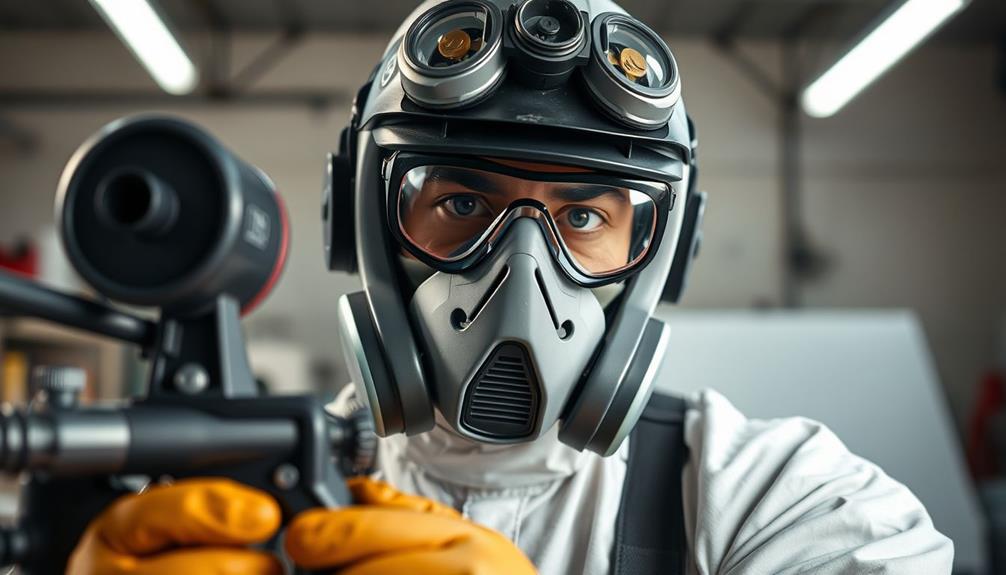
When you're using an airless paint sprayer, wearing the right protective equipment is critical for your safety.
You'll need to guarantee your eyes, skin, and lungs are shielded from potential hazards, which means goggles, proper clothing, and a suitable respirator are fundamental.
Additionally, understanding the importance of reputation and reviews can help you choose a reliable service for any painting needs that may arise.
Let's explore how each piece of equipment plays an essential role in keeping you safe on the job.
Eye Protection Necessity
Using safety goggles is essential for protecting your eyes during airless paint spraying operations. Accidental fluid contact can lead to serious injuries, so always prioritize your eye protection. When choosing safety goggles, look for those with ANSI Z87.1 certification, which guarantees they meet rigorous standards for impact resistance and durability. This is especially important when working with flammable or toxic materials that can cause eye damage if sprayed.
To enhance your safety, consider goggles with side shields, which offer extra protection against particles and overspray. Regularly inspect your goggles for scratches or damage to guarantee they provide adequate protection.
Here's a quick reference table to help you choose the right eye protection:
| Feature | Importance | Recommendation |
|---|---|---|
| ANSI Z87.1 Certification | Guarantees impact resistance | Mandatory for all users |
| Side Shields | Protects against overspray | Highly recommended |
| Regular Inspections | Guarantees goggles remain effective | Check before each use |
| Scratch Resistance | Maintains visibility | Opt for high-quality lenses |
| Flammable Material Warning | Prevents severe eye injuries | Use goggles at all times |
Stay safe and always wear your safety goggles!
Proper Clothing Guidelines
Protecting your body is just as important as safeguarding your eyes during airless paint spraying. To guarantee your safety, you need to wear proper clothing that minimizes exposure to paint and potential injuries. Start with long-sleeved shirts and long pants made of durable, non-flammable materials. This will help protect your skin from accidental splashes and reduce the risk of injection injuries from the paint.
Additionally, wearing proper protective clothing can contribute to enhanced overall well-being while you work.
Don't forget about your hands—chemical-resistant gloves are necessary for shielding them from harmful substances and preventing skin absorption of hazardous materials.
Additionally, sturdy, non-slip footwear is essential. It provides stability and safeguards your feet from spills, which can occur with airless paint sprayers.
While you've already learned about eye protection, remember that your clothing plays a significant role in overall safety. Always be mindful of trigger safety while spraying and make sure your clothing is fitted properly to reduce any risk of entanglement.
Respiratory Safety Measures
Effective respiratory safety measures are critical for anyone working with airless paint sprayers. To protect yourself from harmful fumes and guarantee a safe working environment, follow these key guidelines:
1. Use Proper Respirators: Always wear respirators equipped with organic vapor cartridges tailored for the specific coating you're spraying. Disposable masks won't provide adequate protection against toxic fumes.
Additionally, it's important to be aware of the potential health risks associated with prolonged exposure to these chemicals, as outlined in gout management strategies.
2. Guarantee Proper Ventilation: Conduct your spraying in areas that meet OSHA air change requirements. Good ventilation minimizes the risk of inhaling harmful vapors and helps maintain a safe workspace.
3. Monitor Air Quality: Regularly check the air quality in your spraying area. This practice helps maintain safe levels of airborne contaminants and reduces respiratory risks.
Additionally, keeping your workspace clean and inspecting your respiratory protective equipment is crucial.
Make sure everything is in good condition to minimize hazards while spraying. By taking these precautions, you'll not only protect your health but also create a safer environment for everyone involved.
Proper Maintenance Practices

While maintaining your airless paint sprayer may seem tedious, it's essential for ensuring best performance and safety. Regularly cleaning your sprayer after each use prevents clogs and guarantees consistent results for future projects.
Just like how dog training methods can greatly impact a pet's behavior, proper maintenance can enhance the effectiveness of your sprayer. Before you start, always relieve fluid pressure to avoid accidental injection injuries.
Inspect hoses and connections for leaks before each use; replacing any damaged components is critical for maintaining both safety and efficiency. Following the manufacturer's recommended maintenance schedule is another important step. This often includes flushing the system with appropriate cleaning solutions, which can greatly prolong your sprayer's lifespan.
Keep an updated operator's manual on hand for reference, as it contains specific maintenance procedures and safety instructions tailored to your sprayer model.
Adopting these proper maintenance practices not only enhances the performance of your airless sprayer but also minimizes the risk of accidents. By staying proactive about maintenance, you'll enjoy smoother operations and a safer working environment.
Emergency Response Guidelines

In the event of an injection injury from an airless paint sprayer, it's crucial to act quickly and seek medical help immediately.
Time is of the essence, as the severity of the injury can worsen if left untreated. Incorporating effective weight loss strategies and maintaining a balanced lifestyle can enhance your overall health, which is important when facing emergencies.
Here are key steps to follow:
- Get to an Emergency Facility: Head to the nearest emergency room to guarantee that you receive the appropriate medical attention for the injury.
- Inform Medical Staff: Let the medical team know about the high-pressure injection risk and provide specific details about the type of paint or coating involved. This information is critical for effective treatment.
- Monitor for Delayed Symptoms: Symptoms may not appear right away, so stay vigilant and watch for any delayed reactions that could require further evaluation.
Safe Operating Procedures
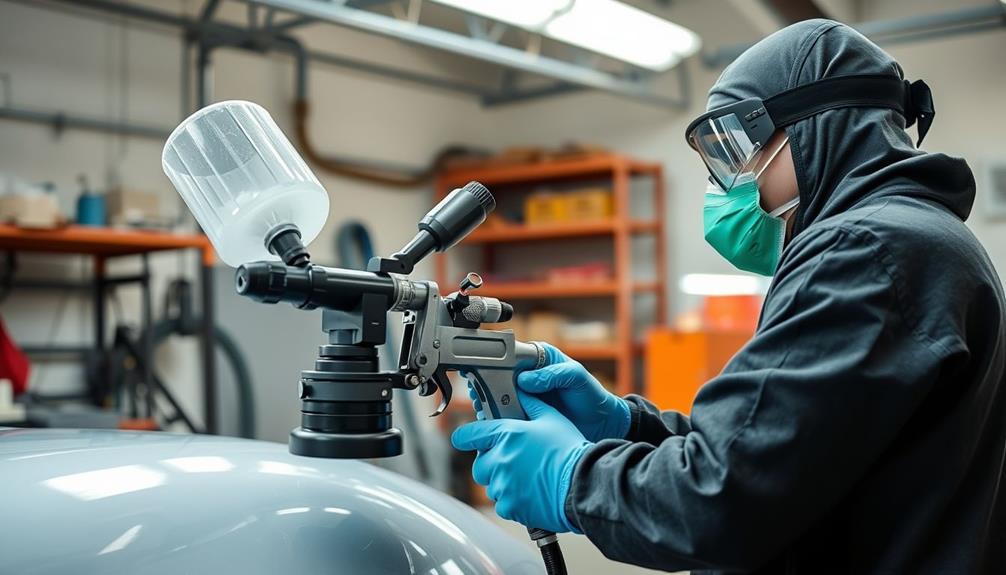
Understanding safe operating procedures is vital for anyone using airless paint sprayers. First, always wear the appropriate personal protective equipment (PPE), like safety goggles and respirators, to shield yourself from harmful fumes and accidental fluid contact.
Guarantee your work area is well-ventilated to reduce the risk of flammable vapors that could lead to fire or explosion.
Before you start, engage the spray gun trigger safety lock when the tool isn't in use. This simple step can prevent accidental activation and potential injuries.
Always relieve fluid pressure before performing any maintenance or cleaning tasks to eliminate the risk of injection injuries from high-pressure fluid.
Regular inspections are important. Check hoses and connections for leaks, and replace any damaged components immediately to maintain safe operating conditions.
Following these safe operating procedures not only enhances airless paint sprayer safety but also protects you and those around you. Your diligence in adhering to these practices is key to a secure and efficient working environment.
Frequently Asked Questions
What Is the Number One Rule When Using Airless Spray Guns?
The number one rule when using airless spray guns is to always use tip guards. They protect you from potential injection injuries caused by high-pressure fluid, ensuring a safer painting experience every time you spray.
What Is a Safety Feature of Airless Spray Guns?
Did you know that nearly 80% of spray-related injuries come from improper use? One essential safety feature of airless spray guns is the trigger safety lock, which prevents accidental discharge when you're not actively using the gun.
Do You Need a Respirator for Airless Paint Sprayer?
Yes, you need a respirator for airless paint sprayers. It protects you from harmful fumes and vapors, especially in poorly ventilated areas. Always choose the right type based on the coatings you're using.
What Are the Safety Requirements for Spray Paint?
When you spray paint, think of it as wielding a powerful brush; safety's your canvas. Always wear PPE, guarantee ventilation, check equipment, and lock the spray gun when not in use to prevent accidents.
Conclusion
So, if you want to become the Picasso of paint while dodging a trip to the emergency room, remember: safety's your best brush. You wouldn't plunge into a shark tank without a life jacket, right? Keep that protective gear on, maintain your sprayer like it's your prized pet, and for heaven's sake, don't play with fire—unless you're roasting marshmallows at a safe distance. Stay sharp, stay safe, and let your walls do the talking, not the first responders!
